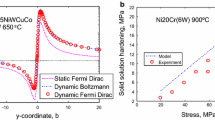Abstract
The simulative accelerated creep test (ACT) was developed as a response to an overall need of gaining in a short time useful physical data for determining long-term behaviour of materials exposed to operation under stress at elevated temperatures in power generation and chemical processing industries. Additionally, the recently frequent power plant shut-downs due to adding solar/wind power to the net call for creep-fatigue data which standard creep tests cannot provide. In response to these needs, a thermal-mechanical fatigue procedure ACT was designed, taking into account physical phenomena causing microstructure transformation during creep, in particular generation of dislocation substructures, their role in nucleation of voids and cracks, intensification of carbide precipitation and decay of mechanical properties during long-time exposure to elevated temperatures. The actual ACT procedure generates adequate data for calculating true lifetime of the tested creep resisting material for a nominal stress.












































Similar content being viewed by others
References
Info on: www.gleeble.com/products.html
Honeycombe RWK (1984) Creep in pure metals and alloys, in the plastic deformation of metals, E. Arnold Publishers, London, on p 356
Sleeswyk AW, Mandziej S (1990) Mobility of <001> dislocations and formation of cleavage nuclei. Scripta Metall Mat 24(1):7–l
Výrostková A (2005) IMR-SAS, Kosice SK, in http://www.cost.eu/domains_actions/mpns/Actions/ 538, Case study in COST-538 Action, unpublished
Stroh AN (1957) A theory of the Fracture of metals. Adv Phys 6:418–465
Mandziej ST (1993) Low-energy dislocations and ductility of ferritic steels. Mater Sci Eng A 164:275–280
Sleeswyk AW, Mandziej ST (1988) In: Kettunen PO et al (eds) Dislocation behaviour in dual-phase steel, in: 'Strength of metals and Alloys', vol III. Pergamon press, Oxford, pp 155–160
Lubahn JD, Felgar RP (1961) Plasticity and Creep of Metals. J. Wiley & Sons Inc, New York
Mandziej ST (2017): Microstructures of heat-affected zones in Cr-Mo-V steels; IIW doc. II-C-514-17
Gleeble Welding Simulation Brochure 6.12 (2016) DSI, Poestenkill NY, USA
Mandziej ST (2017) Accelerated creep test for new steels and welds. In: Liu X et al (eds) Energy materials, The Minerals, Metals & Materials Series. Springer Verlag, pp 161–170
Rothwell J, Abson D (2010) Performance of weldments in advanced 9%Cr steel - 'FB2'. Mater High Temp 27:253–264
Kasl J, Jandova D, Kanta V (2019) Behaviour of dissimilar weld joint of steels FB2 and F during long-term creep test. IOP Conf Ser Mater Sci Eng 461:012036
Kidin IN (1969) Kinetics of Thermal processes at different heating methods, on p.42 and electrothermal treatment of alloy steels, on p.191. In: Fizicheskie Osnovy Elektrotermicheskei Obrabotki Metallov i Splavov (physical principles of Electrothermal treatment of metals and alloys), Moscow: Izd. Metallurgia (in Russian)
Mandziej ST, Vyrostkova A (2008) Evolution of Cr-Mo-V weld metal microstructure during creep testing—part 1: P91 material. Weld World 52(1–2):3–26
EU R&D 5th FP project “SmartWeld”, No. GRD 1–2000-25352, unpublished
Mandziej ST (2005) In http://www.cost.eu/domains actions/mpns/ Actions/ 536, ACT study in COST-536 Action, unpublished
Mandziej ST (2013) Remnant life estimation for repair welding in thermal power generation. In: design, fabrication and economy of metal structures, Proc.Int.Conf. Miskolc, Springer, Hungary, p 263–271
Author information
Authors and Affiliations
Corresponding author
Additional information
Publisher’s note
Springer Nature remains neutral with regard to jurisdictional claims in published maps and institutional affiliations.
Recommended for publication by Commission II - Arc Welding and Filler Metals
Rights and permissions
About this article
Cite this article
Mandziej, S.T. Physical background and simulation of creep in steels. Weld World 64, 1119–1134 (2020). https://doi.org/10.1007/s40194-020-00903-5
Received:
Accepted:
Published:
Issue Date:
DOI: https://doi.org/10.1007/s40194-020-00903-5




